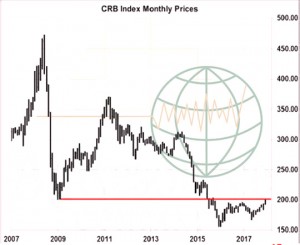- In early 2015, the CRB Index fell below the low that was set back in 2009. A major low was set the following year in 2016, and a secondary low was again set last summer. Since then the commodity index has rallied back through the 2015 breakout. With the US economy growing, many commodity traders are discussing the potential of rising US inflation and the impact that could be felt in commodity markets. Markets will be closely listening to the State Of The Union address, and then again for Janet Yellen’s final FOMC Meeting announcement.
- The EU and GFS weather models are in agreement on a split S American weather pattern for at least the next two weeks. Dryness prevails across Argentina and looks to be sustained into the 15th. The lack of topsoil moisture in Argentina will maintain high temps in the 90s, and at times lower 100’s. The heat and dryness will produce acute stress on Argentine corn and soybean crops. The forecast is warm to hot amid drying topsoil. Highs will reach the mid 90’s to lower 100’s. The excessive heat will prevail into mid February. Additionally, daily heavy rains are ahead for much of N Brazil. This shouldn’t affect later developing bean fields, but weekly totals upwards of 7-12” will slow early bean harvesting, and thus raise questions about safrinha corn acreage in pockets of Mato Grosso and Goias. Also, enduring mud could slow truck traffic northward to export ports. This is a stable summer weather pattern that is concerning for a deepening Argentine drought. We see no indication of a pattern change. The strength of the jet stream amid La Niña looks to maintain parched weather with above normal temperatures.
- The 14 day US weather forecast is unchanged and maintains dry weather into the middle of February. Trace amounts of rain/snow are possible in the Dakotas, but otherwise a pattern of complete dryness and cold temperatures will prevail for the next two weeks. The jet stream will lift northward in the last half of February. Whether moisture falls with this northern migration of the jet stream will be key for spring soil moisture. Starting in early March, the dryness across the Central US will become more concerning for 2018 US spring and summer row crops. A high pressure ridge looks to hold across the SW US with the upper air flow coming out of the Pacific Northwest. Snow totals across the Rockies will be extremely limited and the drought looks to worsen. The dryness is worrisome as sub soil moisture reserves are in fast retreat. The middle of February is highly important for a wetter pattern to develop.
- Soybean and meal futures continued higher through Tuesday as funds continued to cover their short soybean position and add to their long meal position. The Argentine forecast offered hardly any changes, with very little rain and well above normal temperatures lasting into mid February. Commodity fund traders were estimated buyers of 11,000 soybean, 5,500 soymeal, and 3,000 soyoil contracts.The EIA will release the January Biodiesel Production report on Wednesday, with data for November. Total soyoil use and substitution of other products will be just as important as the actual biodiesel numbers. Corn oil prices have been in decline for over a year, as most ethanol plants have invested in technology and equipment to extract oil from DDG’s. Biodiesel plants prefer soyoil, but have been steadily increased use of alternatives, including corn oil in the last year as the corn/soy spread has slipped to a three year low. Spot futures close through the first of several a major weekly trend lines, and without a change in the Argentine forecast, we expect that breaks continue to find demand from short funds and end users.
- A dire Argentine weather forecast mixed with still heavily short commodity funds continued to support Chicago corn trade through Tuesday. Spot corn was back over $3.60 for the first time since August, while most new crop contracts were back $4. Both weekly and monthly ethanol data will be out on Wednesday. The monthly data for November is approximately known, and expected to be slightly better than the October figures, while nearby output is expected to stay firm. Ethanol plant margins for IL and NW IA, have largely stayed profitable over the last year. IA margins spiked lower at the start of the year, but are estimated this week at $.04/gal, with IL plants estimated to be making close to $.13/gal. Our price targets are coming into view, though a much stronger rally could unfold if much needed rains do not soon fall in Argentina. The outlook stays bullish corn.
- Kansas March wheat futures gapped higher today. Yesterday, the USDA released winter wheat crop conditions, that for some states, showed ratings that were the lowest since Jan condition reports first began to be released (e.g. 2006 for KS, 2010 for OK). Funds were thought to have bought 6,500 contracts of Chicago wheat contracts. Yesterday, funds were estimated to be short 112,000 contracts. The Kansas March futures contract closed at $4.70. That is up 17 cents and was the high of the day. SRW futures rose nearly 9 cents, while the Minneapolis Mar contract only managed to eke out a 3 cent gain. On the Kansas nearby futures chart $4.80 is resistance. If the contract closes above that level, the next target would be $5.00 then $5.50. SRW Mar futures closed at $4.58, just shy of our upside target of $4.60- $4.65.

